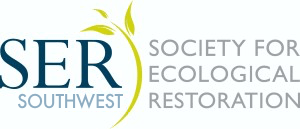2017 Annual Conference of the
Society of Ecological Restoration –
Southwest Chapter
December 6-8, 2017
Hotel Albuquerque
Albuquerque, New Mexico
SER-SW 2017 Annual Conference Program
Check out PHOTOS from the SER-SW 2017 Annual Conference
THANK YOU TO ALL OUR SPONSORS WHO MADE THIS EVENT POSSIBLE
[wppa type=”slideonly” album=”17″ size=”350″ align=”center”][/wppa]
Presentations
FEATURED SPEAKERS:
US Forest Service Southwest Regional Restoration Program
John Waconda
How do we map Restoration Ecology onto a rapidly changing world?
Don Falk
PLENARY SESSIONS:
Native Plants and Partnerships Through the Border: Networking and Expanding Capacity in Mexico
Claverie
Mojave Desert Native Plant Program: Putting the Right Seed in the Right Place through Implementation of the National Seed Strategy in the Mojave Desert Ecoregion
Perkins
Trends in vegetation recover after land treatments in the SW United States: associations between environmental variables, ground-based measurements, and satellite greenness patterns
Copeland
Current Distribution and Anticipated Impacts of the Tamarisk Beetle (Diorhabda spp.) Across the Southwest
Bloodworth
The Changing Landscape of the Manzano Mountains Following Four Large Wildfires
Stropki
SER Certified Ecological Restoration Practitioner Program and other SER Updates
Walder
CONCURRENT SESSIONS:
Topic: Drylands Restoration
Suggested Practices for Biological Soil Crust conservation and Management in the Arid Southwestern United States
Bengston
Soil Health and Erosion Control
Kerby
Upland Restoration to Enhance Recovery Efforts for and Endangered Pupfish
Gold
Comparison of trailside degradation across a gradient of trail use in the Sonoran Desert
H. Rowe
Vegetation Recovery along Transmission Power Line Corridors in the Colorado Desert of Southern California
Prabhu
Topic: Riparian Restoration
Ecological Success Criteria for Riparian Habitat in the Colorado River Corridor in Mexico
Schlatter
UAV photogrammetry modeling of the Rio Grande silvery minnow habitat restoration project in Albuquerque, New Mexico: geomorphological, inundation, and vegetation changes over time
Whitehead
Habitat Restoration and management of Native and Non-native Trees in Southwestern Riparian Ecosystems
Volke
Process for Expanding Nursery Habitat for the Federally Endangered Rio Grande Silvery Minnow along a 31-Mile Reach of the Middle Rio Grande, New Mexico
Caplan
Upper Gila River Restoration
Bove
Topic: Seeding and Plant Materials
Exotic root-rotting Phytophthora species detected in restoration plantings and nursery stock
VinZant
Building a Southwest Seed Partnership: a public-private initiative to supply native plant materials to southwestern restoration projects
Stone
Testing the efficacy of ripping, seeding, and seed band applications for restoring impacted soils in the Sonoran Desert
H. Rowe
Direct Seeding and Seedling Production as a Tool for Restoring Riparian Habitats
Bunting
Seeding vs natural recruitment: comparing semi-arid vegetation communities post reclamation
Farrell
Topic: Assessment and Monitoring
Environmental monitoring for the Rio del Norte Trail restoration project, Albuquerque, NM
Lightfoot
The value of site assessments to inform restoration design and planning- A case study at Arlington Wildlife Area In-Lieu Free Mitigation Site in Arizona
Banerjee
Hydrologic Monitoring pre-Grade control Structure Installations, heard Scout Pueblo, Phoenix, Arizona
Tosline
Northern tamarisk beetle (Diorhabda carinulata) effects on established tamarisk-feeding invertebrate populations along the Las Vegas Wash, Clark County, Nevada
Eckberg
The economics of buffelgrass control
J. Rowe
Topic: Restoration and Conservation
Integrating Ecologies & Economies: The Borderland Restoration Network
Kurt Vaughn
Plant functional traits and local climate conditions determine restoration success and failure on the Colorado Plateau
Balazs
Local youth Take Charge of Restoring Border Ecosystems: Borderland Earth Care Youth Institute Looks Forward
Christopher
Restoration as an Embodied Arts Practice: Engaging Communities in Land Stewardship
McNellis
Cowboy Restoration: Wrangling Springsnails, Mules and the Elements
Plath
Bioretention ponds, Acacias, Swales, Arroyos and other little appreciated “Natural Areas” as a Source of Restoration and Education
DePew
Golf course closures in the SW United States: Opportunities for conservation
Cederberg
Topic: A Changing Climate
Creating Restoration Planting Palettes to Support Pollinators in a Changing Climate
Campbell
Habitat patches support rich and abundant resident pollinator communities to minimize use of restoration resources in arid lands
McCormick
Climate Landscape Response (CLaRe) phenometrics for southern AZ and CA using Prism and MODIS data and leveraging the PICO
Devesh
Field Trips:
Indian Pueblo Cultural Center
The Indian Pueblo Cultural Center is a world-class museum and cultural center created as a place where Pueblo people can tell their story. As the gateway to the 19 Pueblos of New Mexico, the IPCC is a necessary first stop for visitors to New Mexico, providing an introduction for understanding the state’s landscape, legacy, and story of continuance. Known for its collection of Pueblo pottery and murals painted by Pueblo artists, the IPCC also offers an exciting schedule of cultural, educational, and community activities.
Bosque Ecosystem Monitoring Program
The Bosque Ecosystem Monitoring Program (BEMP) strives to be an essential resource for managers of the Rio Grande and its riverside forest, the bosque. Across 31 active monitoring sites along over 300 miles of river, BEMP deploys thousands of K-12 students to not only gather key field data to determine the success of different interventions but also builds connections between students and their watershed. This field trip will include an orientation of BEMP, how citizen science can be used to monitor restoration projects, lessons learned, and planning and budgeting for citizen science support.
Santa Ana Pueblo Native Plant Nursery
The Santa Ana Native Plant and Tree Nursery provides over 250 species of low-water use plant materials, including herbaceous perennials, annuals and biennials; herbs, grasses, trees, shrubs and vines; and vegetable transplants. The nursery is located 2 miles north of Bernalillo, and this field trip will include a behind the scenes tour with nursery staff.
Note: Field trips were covered by conference registration fee!
